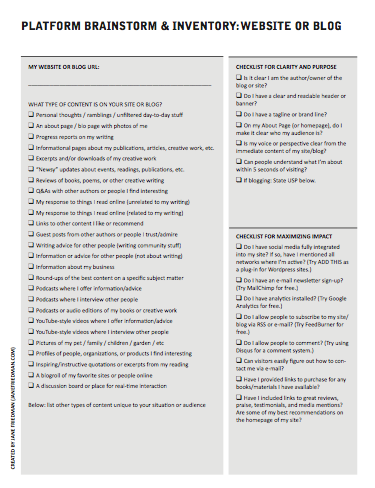
Last weekend at the Midwest Writers Workshop, I offered a workshop on author platform building. Part of the workshop included 5 worksheets to help writers take an inventory of their platform (as it stands today), and also brainstorm how to better grow it.
Good news for you: I’m making my platform worksheets available for free.
Below I’ve offered an explanation of each worksheet.
New writers may think they don’t have a “platform,” but everyone does. It might not be big or dramatic, but you do have one. These worksheets help you think about that platform from multiple angles, and for those who are advanced enough, you can also put some numbers behind it.
Note: If the term “platform” is new to you, in short, it can be defined as whatever gives you visibility and an ability to connect with readers. I gave some fundamental advice about developing platform in this blog post at my Writer’s Digest blog: The Hardest Part About Developing Platform
A brief guide to the 5 worksheets
- Content. This worksheet helps you brainstorm all the content you currently own rights to, and prompts you to think of ways you might repurpose it for different mediums or channels.
- Website/Blog. This worksheet is especially helpful for fiction writers or poets who aren’t sure what to blog about. The checklist acts as a prompt/creativity tool to get you thinking beyond “I’ll just write about my own work.” I’ve also included a checklist of questions about your site’s purpose, and how to maximize its impact. Note: USP stands for “unique selling proposition”—and if you can’t fit the USP into the space provided, it’s probably too complicated or unfocused.
- Social Media. This worksheet takes stock of your social media presence, and prompts you to think about where your audience might actually hang out (rather than just where other WRITERS hang out).
- Relationships. This is the invisible fuel of just about everyone’s platform. It’s hard to make progress if you’re working alone. Most people are (pleasantly) surprised when they really start to think of the number of people and organizations they know.
- Actual Reach. This worksheet can be especially helpful if you’re putting together a book proposal, or doing a 6-month or annual inventory of where and how you seem to be succeeding. It is somewhat limited and could be crass, depending on who you are (numbers don’t tell the whole story, not by a long shot), but metrics can be essential in being more efficient with your efforts. (Note: Book sales and downloads are also part of your metrics; add those if applicable to you.)

Jane Friedman has spent nearly 25 years working in the book publishing industry, with a focus on author education and trend reporting. She is the editor of The Hot Sheet, the essential publishing industry newsletter for authors, and was named Publishing Commentator of the Year by Digital Book World in 2023. Her latest book is The Business of Being a Writer (University of Chicago Press), which received a starred review from Library Journal. In addition to serving on grant panels for the National Endowment for the Arts and the Creative Work Fund, she works with organizations such as The Authors Guild to bring transparency to the business of publishing.

Love these worksheets! I will definitely be using these again and again as I build and develop my platform. Thank you so much for sharing these!
A pleasure!
Thanks Jane, these are super. They will be used and passed on to my clients!
Excellent! They are made to be shared. 😉
Thank you!!!
🙂
Jane, I love the platform worksheets. I was so looking forward to meeting you this coming weekend at the Willamette Writers Conference, but I’m stuck in Seattle and can’t make it after all. I’m teaching a class this fall about platform and would love to use you as the guru my students should turn to. I’ll sign up and take your WD class since I can’t make it to Portland (my home town) this weekend. Hope to connect sometime soon. Mindy @ mindyhalleck.blogspot.com
Sorry to hear I won’t see you at Willamette, but look forward to seeing you in the WD class (or at a future conference)!
How encouraging and empowering! Thanks so much for sharing.
Thanks for dropping by!
Thanks again Jane. As I have said before, you take such good care of us.
🙂 I try.
Great resources, Jane! Thanks so much for sharing. It’s one thing to watch your “numbers” grow on a day-to-day, real time basis, but these really help you step back and see the forest
Exactly! (Sometimes watching daily changes can drive you crazy.)
[…] Draft Your Platform Worksheets (your platform means how you get seen and found – could be a book, a blog, public speaking, etc). […]
Terrific worksheets, Jane, even for non-writers. I’m struggling to bring a group of non-profit organizations into the social media world and they’re having trouble with just about everything associated with it: many of their leaders are “digital dinosaurs,” not even “digital immigrants,” and on top of that, marketing is a foreign–and frightening–concept to them (they’re mostly ex-military). These worksheets could give them something to start from. Would you mind if I tweaked the worksheets to fit into their world better, with full credit to you as the original creator, of course?
I agree—these worksheets can be helpful to anyone or any organization who needs an online marketing plan. Feel free to tweak & share.
Thanks!
Thanks!
[…] Draft Your Platform Action Plan: 5 Worksheets | Jane Friedman "Last weekend at the Midwest Writers Workshop, I offered a workshop on author platform building. Part of the workshop included 5 worksheets to help writers take an inventory of their platform (as it stands today), and also brainstorm how to better grow it." […]